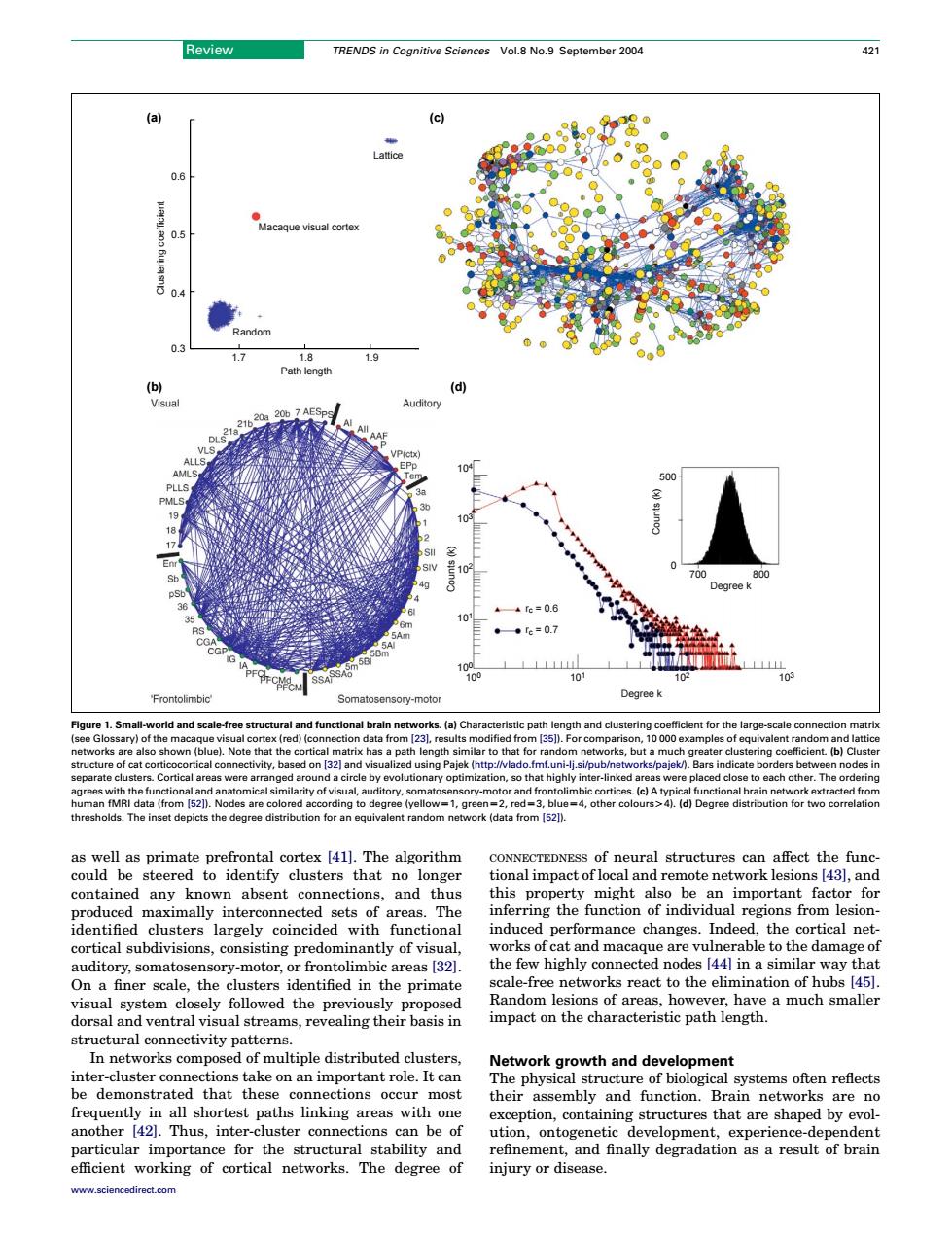正在加载图片...

Review TRENDS in Cognitive Sciences Vol.8 No.9 September 2004 a 0 fc =0.6 。—。6=07 1000 .te)A D 1521 tal 143L. contained any known absen ections and thus his be an important factor imalyinteiacaode sets of areas. The 11 argely lt of rks of cat and macaque are vulnerable to the damage of uditory somat sensory-motor.or frontolimbic areas 32 th highly connecte node 8【441nas1m1 way that On a finer scale,the clusters ntified in the primat r have a much smaller impact on the characteristic path length. structural connectivity patterns Network growth and development tion Th us,inter ster be( t development. experienc as well as primate prefrontal cortex [41]. The algorithm could be steered to identify clusters that no longer contained any known absent connections, and thus produced maximally interconnected sets of areas. The identified clusters largely coincided with functional cortical subdivisions, consisting predominantly of visual, auditory, somatosensory-motor, or frontolimbic areas [32]. On a finer scale, the clusters identified in the primate visual system closely followed the previously proposed dorsal and ventral visual streams, revealing their basis in structural connectivity patterns. In networks composed of multiple distributed clusters, inter-cluster connections take on an important role. It can be demonstrated that these connections occur most frequently in all shortest paths linking areas with one another [42]. Thus, inter-cluster connections can be of particular importance for the structural stability and efficient working of cortical networks. The degree of CONNECTEDNESS of neural structures can affect the functional impact of local and remote network lesions [43], and this property might also be an important factor for inferring the function of individual regions from lesioninduced performance changes. Indeed, the cortical networks of cat and macaque are vulnerable to the damage of the few highly connected nodes [44] in a similar way that scale-free networks react to the elimination of hubs [45]. Random lesions of areas, however, have a much smaller impact on the characteristic path length. Network growth and development The physical structure of biological systems often reflects their assembly and function. Brain networks are no exception, containing structures that are shaped by evolution, ontogenetic development, experience-dependent refinement, and finally degradation as a result of brain injury or disease. Degree k Counts (k) Degree k 101 101 100 100 102 102 103 103 104 Counts (k) 0 500 700 800 0.3 0.4 0.5 0.6 1.7 1.8 1.9 Path length Clustering coefficient Lattice Macaque visual cortex Random (a) (b) (c) (d) rc = 0.6 rc = 0.7 Figure 1. Small-world and scale-free structural and functional brain networks. (a) Characteristic path length and clustering coefficient for the large-scale connection matrix (see Glossary) of the macaque visual cortex (red) (connection data from [23], results modified from [35]). For comparison, 10 000 examples of equivalent random and lattice networks are also shown (blue). Note that the cortical matrix has a path length similar to that for random networks, but a much greater clustering coefficient. (b) Cluster structure of cat corticocortical connectivity, based on [32] and visualized using Pajek (http://vlado.fmf.uni-lj.si/pub/networks/pajek/). Bars indicate borders between nodes in separate clusters. Cortical areas were arranged around a circle by evolutionary optimization, so that highly inter-linked areas were placed close to each other. The ordering agrees with the functional and anatomical similarity of visual, auditory, somatosensory-motor and frontolimbic cortices. (c) A typical functional brain network extracted from human fMRI data (from [52]). Nodes are colored according to degree (yellowZ1, greenZ2, redZ3, blueZ4, other coloursO4). (d) Degree distribution for two correlation thresholds. The inset depicts the degree distribution for an equivalent random network (data from [52]). Review TRENDS in Cognitive Sciences Vol.8 No.9 September 2004 421 www.sciencedirect.com